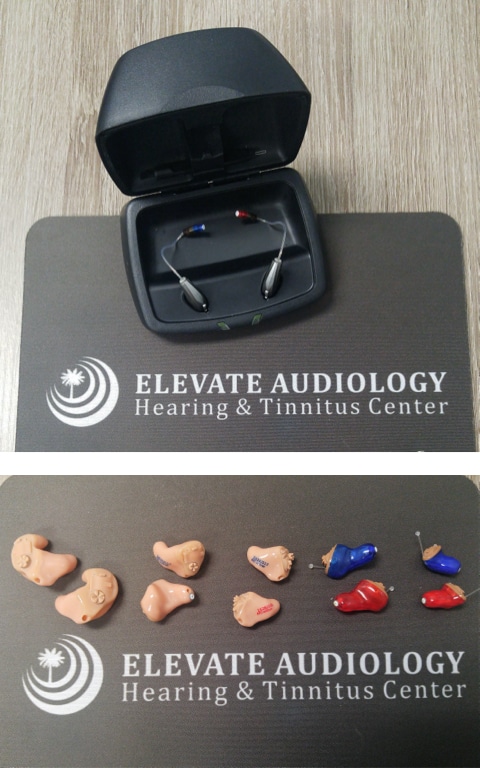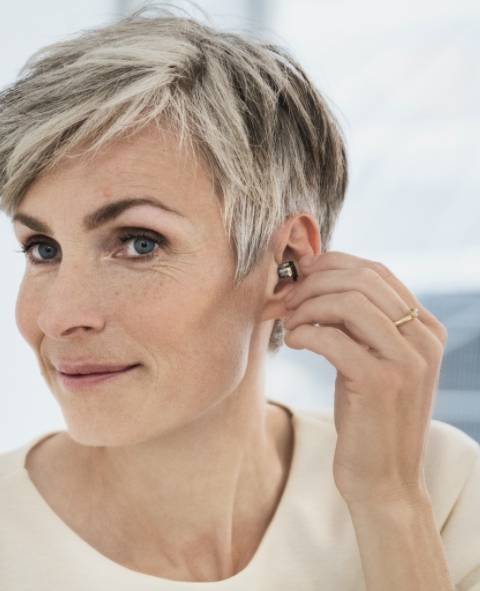Hearing Aid Improvements
Hearing aids are truly amazing pieces of technology! They have improved greatly with the advent of digital technology. If you’re picturing big and bulky devices with questionable sound quality, you’ll be pleased to learn today’s instruments are smaller, more comfortable, and provide sound that is more natural than ever before. They are available in a variety of sizes and styles, so finding one that appeals to your lifestyle needs and cosmetic preferences should be easy.

What are the Different Types of Hearing Aids?
Receiver-in-the-Canal (RIC)
The most common style hearing aid around the world. The RIC style is the most versatile because the speaker sits inside of the ear canal allowing for a natural sound quality while the rest of the electronic components of the hearing aid sit at the top of the outer ear. Because the speaker (also known as the receiver) is external, the power of this hearing aid can be changed to accommodate changes to hearing. It is coupled to the ear with a custom earmold or a dome. It’s a small and discreet unit but powerful enough for treating significant hearing loss.
Behind-the-Ear (BTE)
A BTE device is curved to match the contour of the ear and rests directly behind the ear. The housing, which contains all the electronics, is encased in plastic and connects to the ear canal with a custom ear mold.
Though more visible than other styles, the BTE powerful enough for severe to profound hearing losses.
Completely-in-the-Canal (CIC)
This hearing aid is placed in the ear canal. It takes advantage of the ear’s natural ability to collect sound and may have a control on the device to adjust the volume. Its discreet size makes the device virtually invisible to others.
The trade-off is a shorter battery life, and it may prove difficult to adjust for those with poor manual dexterity. This is a good choice for mild to moderate hearing loss.
In-the-Canal (ITC)
This style is also designed to fit in the ear canal, but not as deeply as an IIC device, resting securely in the lower portion instead. It’s a little larger, making it easier to insert and remove and extending the battery life.
Best for patients with mild to moderate hearing loss.
This style is now also available in rechargeable.
In-the-Ear (ITE)
This hearing aid is designed to fill the outer portion of the ear, and is larger than those worn in the ear canals. It is less discreet, but the size allows for more features and makes the unit easier to adjust.
A bigger battery translates to longer life and means those with severe or profound hearing loss can benefit from this style.
This style is now also available in rechargeable.

Hearing Aid Technologies
Hearing aid technology has improved drastically over the past couple of decades. Early devices relied on vacuum tubes and bulky batteries, but today’s instruments take advantage of digital signal processing, microchips and computerization. Keeping track of the latest technological features can be challenging, but we’ll cover a few of the more popular options here.
Some of the breakthroughs in hearing aid technology include the following:
- Rechargeability, gone are the days of hearing aid batteries dying in the middle of an important conversation. Rechargeable hearing aids are very popular.
- Smartphone connectivity allows most hearing aids to pair with most cell phones for ease of phone communication, streaming music and video audio, use of remote control apps, and connection to “the cloud”.
- Gain processing, which reduces background and microphone noise for a clearer sound.
- Digital feedback reduction with built-in cancellation, which reduces or eliminates squelching and feedback. No more squealing in church!
- Digital noise reduction, which reduces background noises for better, more reliable speech recognition.
- Directional microphones, which provide better directionality by having one microphone focus on the sound source while the other decreases background noise.
- Automatic programming, which utilizes preset programs that automatically adapt to a range of different sound environments.

Choosing a Hearing Aid
If you are experiencing hearing loss, odds are good that you’ll benefit from a hearing aid. But choosing the right one is no simple task. Today’s hearing aids are smaller and more feature-packed than their predecessors, offering an array of options.
Narrowing the choices down can be tough, but there are a few important things you should take into consideration before choosing a hearing aid.

What Are Your Hearing Needs?
First, we must assess your hearing loss. Severity is measured in degrees, based upon your hearing loss range in decibels. It ranges from normal (-10 to 15 dB) to profound (91+ dB), with a total of seven different degrees.
The degree of hearing loss typically changes at different frequencies so you may hear vowels better than consonants or men’s voices easier than women’s voices. Hearing is not “all or nothing”.
It is equally important to measure speech understanding since we do not communicate via beeps. Speech understanding, word recognition, and understanding of sentences in noise help determine what information the individual’s brain is getting and what parameters may be more difficult than others. This allows us to set realistic expectations and goals.
Additional considerations that will help Dr. Tarvin pair you with the right hearing aid include:
Lifestyle Needs: Functionality is an important consideration. With so many available features, you’ll need to decide which ones matter most to you. Features like Bluetooth® connectivity, automatic volume control, rechargeable batteries, App connectivity, and AI-Assisted on the fly adjustments are becoming more commonplace, but aren’t available in all models yet.
Cosmetic Preferences: Hearing aids are available in a variety of sizes and styles, some visible while others are implanted deep within the ear canal, rendering them virtually undetectable. Many are custom-molded to fit each individual’s ears.
Budgetary Considerations: Some of the cheaper, entry-level products are not classified as hearing aids by the FDA, which requires devices to meet stringent guidelines. Having a professional assist you with the product decision ensures you are protecting your hearing health.








Benefits of Hearing Aids
Overall Health
Hearing aids may promote better general health by reducing self-rated psychosocial hearing difficulties and promoting a more active, engaged lifestyle. (Dawes and colleagues, 2015)
Social Interactions
By facilitating improved communication, hearing aids may improve mood and increase social interactions, thereby perhaps impacting scores on cognitive tests. (Amieva and colleagues, 2015)
Listening Effort
Patients may feel less exhausted after an hour of socializing and can engage more easily with family and friends.
Cognitive Health
People with dementia put a good deal of effort into communicating. Hearing technology could reduce the cognitive effort and resource allocation (studies currently being performed regarding this).
Learn more about the benefits of treating your hearing loss
We help you make the most informed decision
Hearing aids range widely in cost; finding the right product for your needs depends upon a thorough hearing evaluation and communication needs assessment by our audiologist, who will provide a recommendation perfectly suited for your specific situation.
